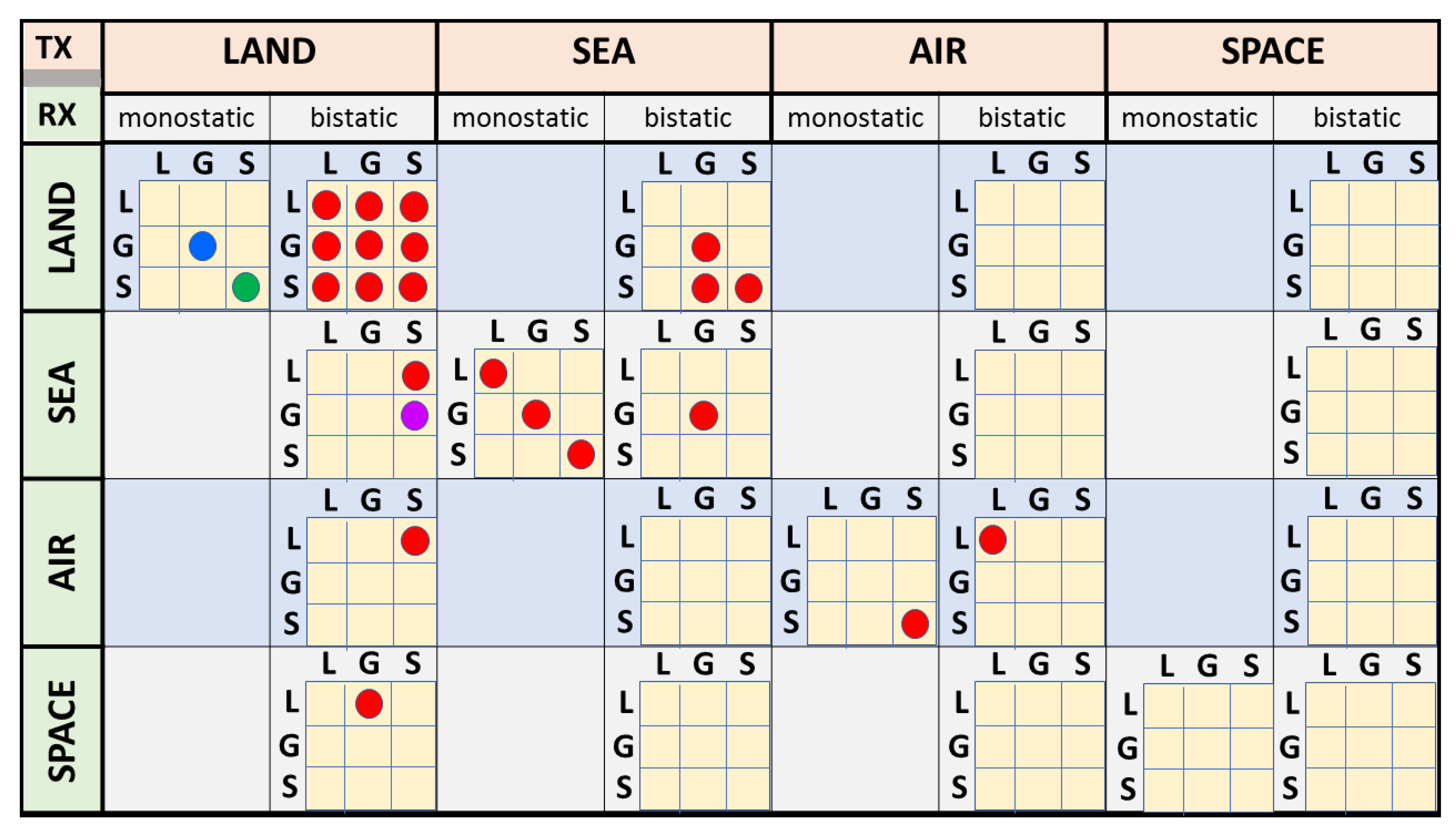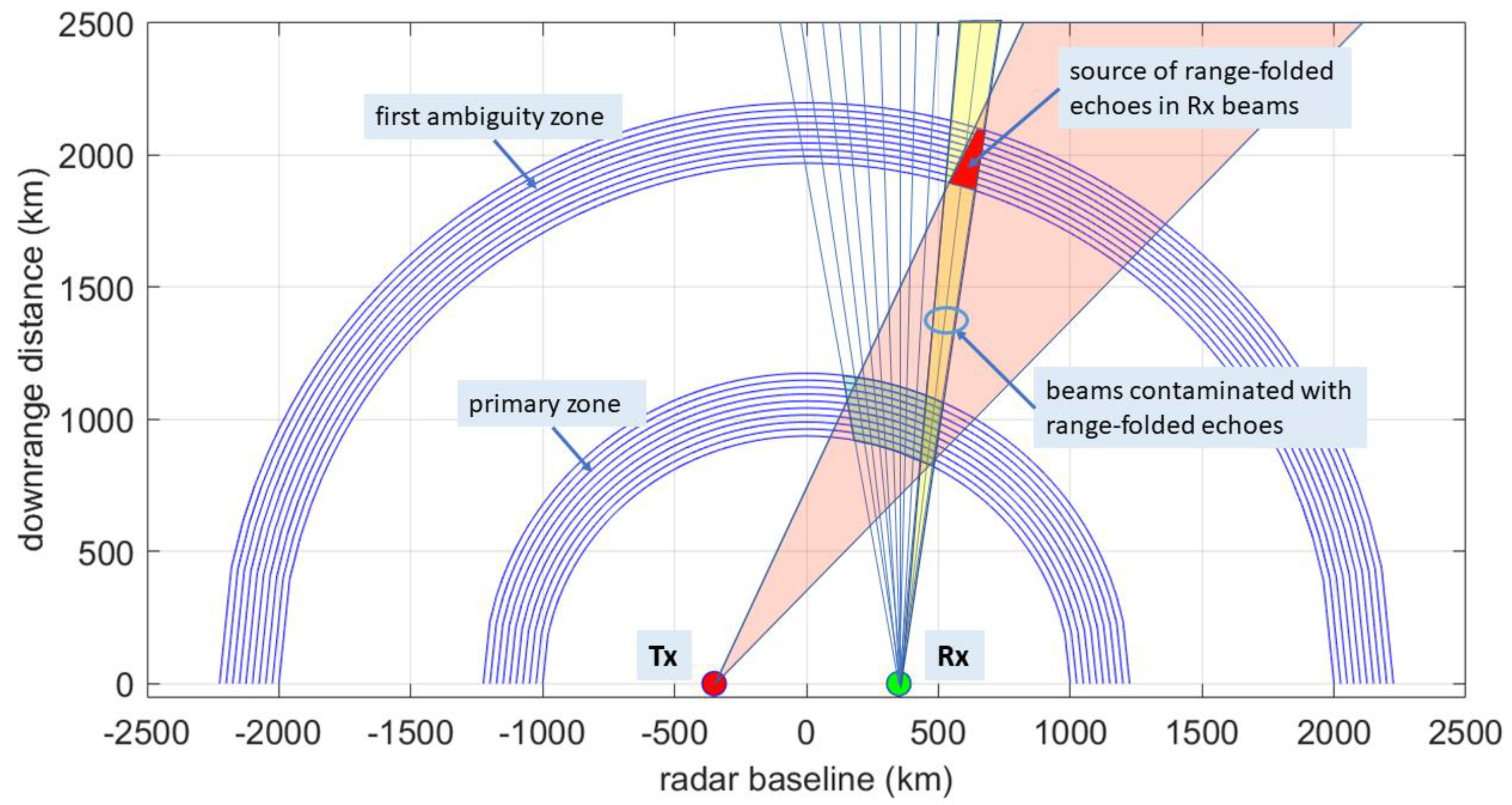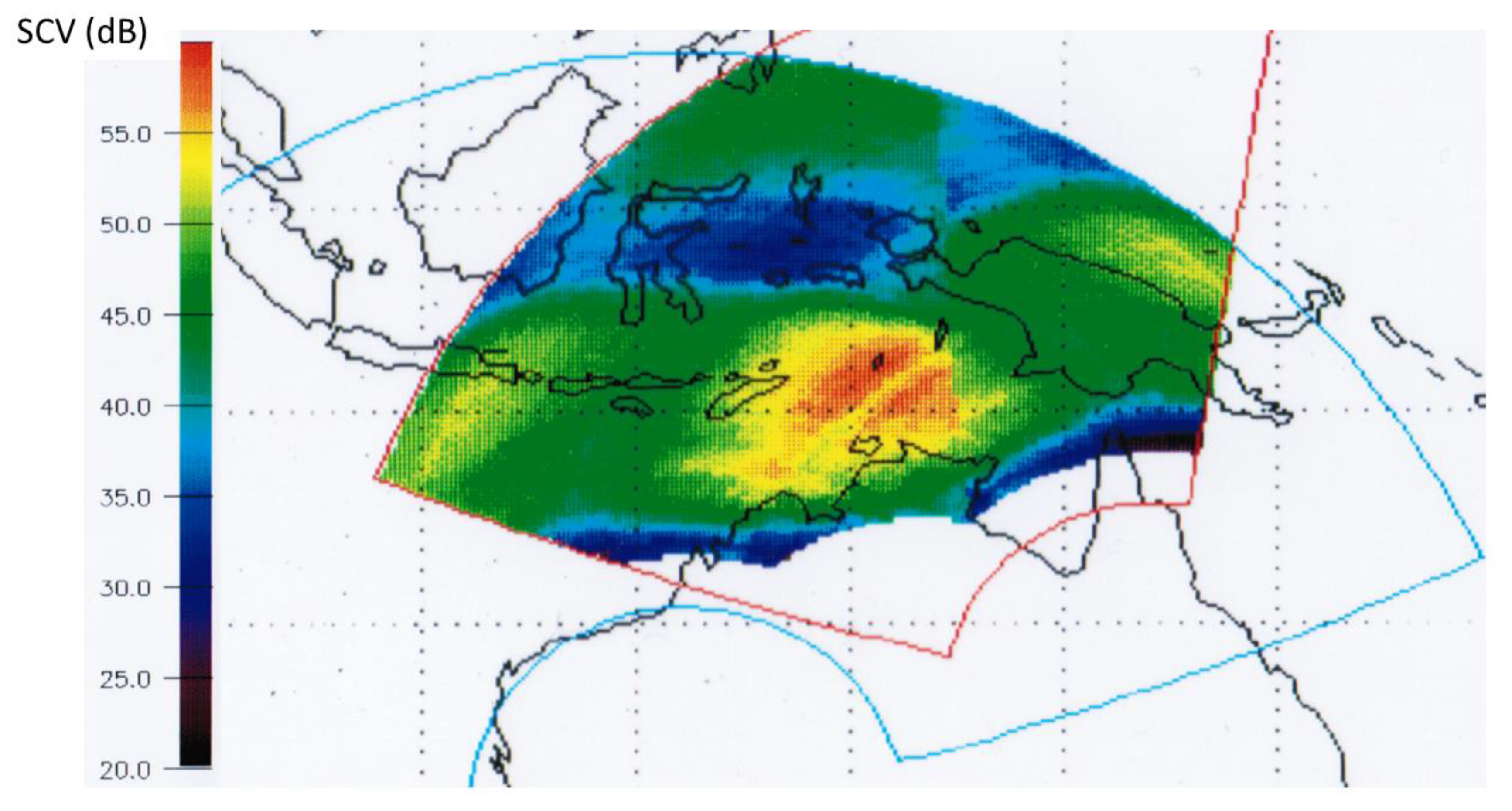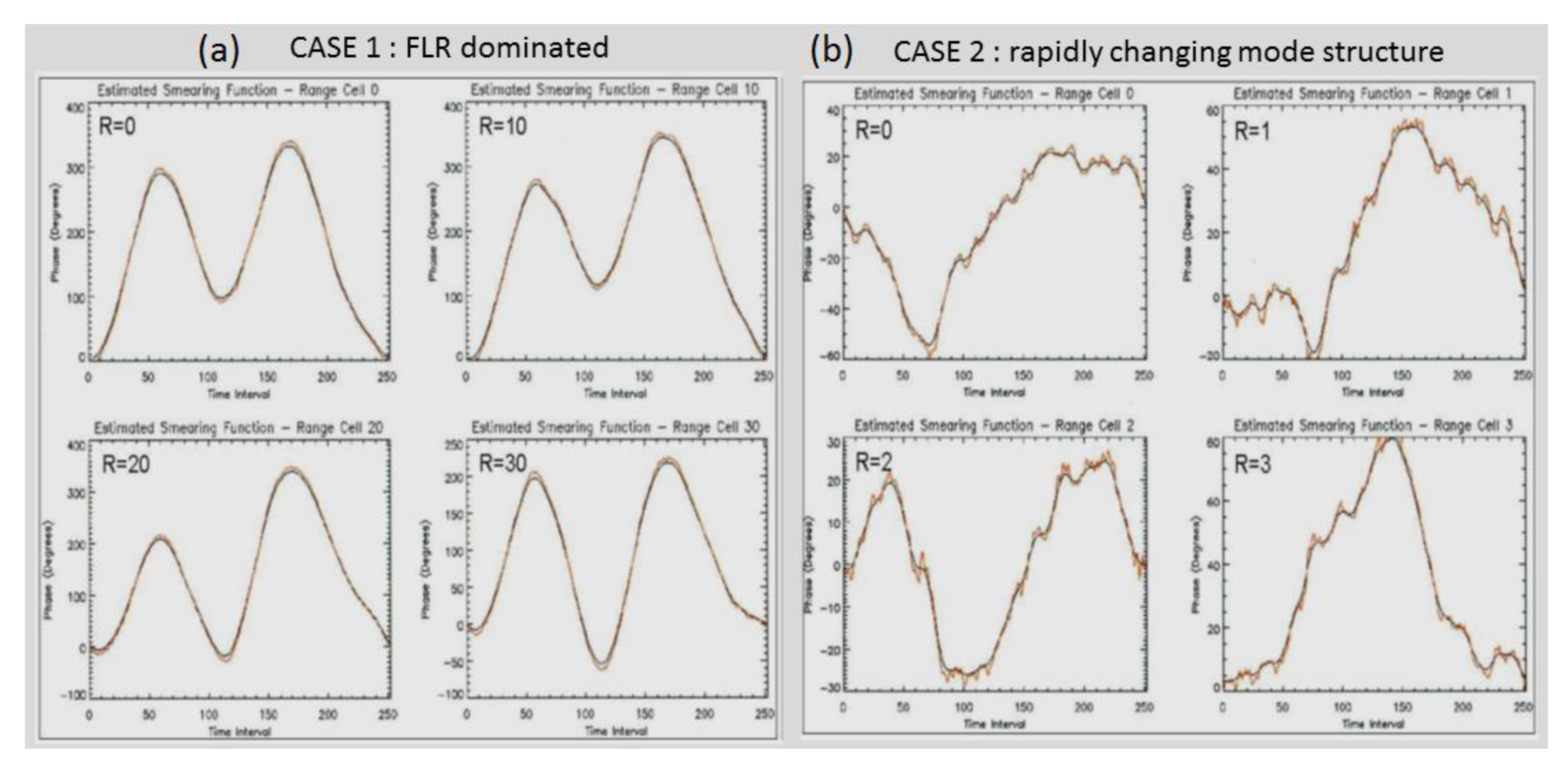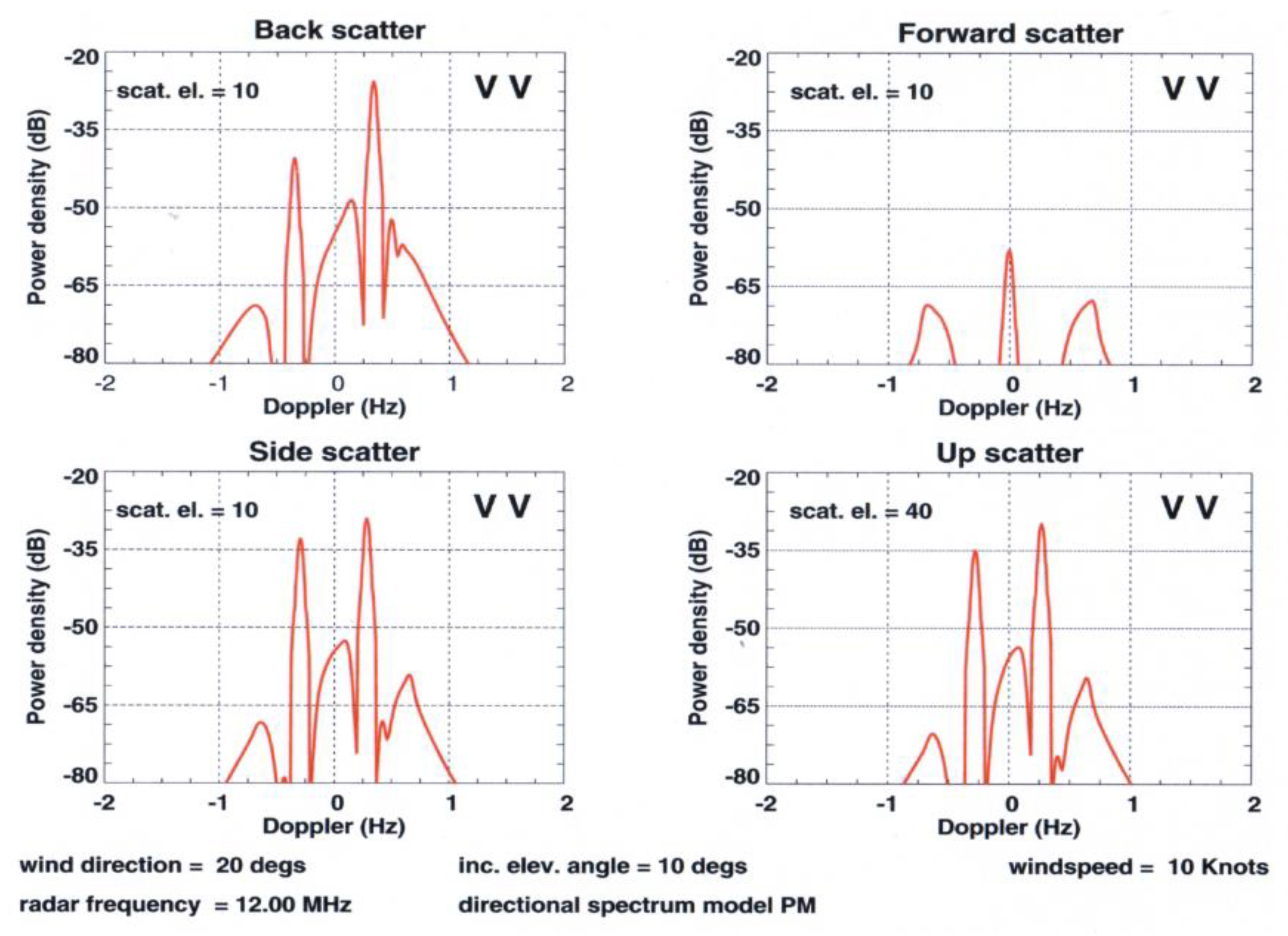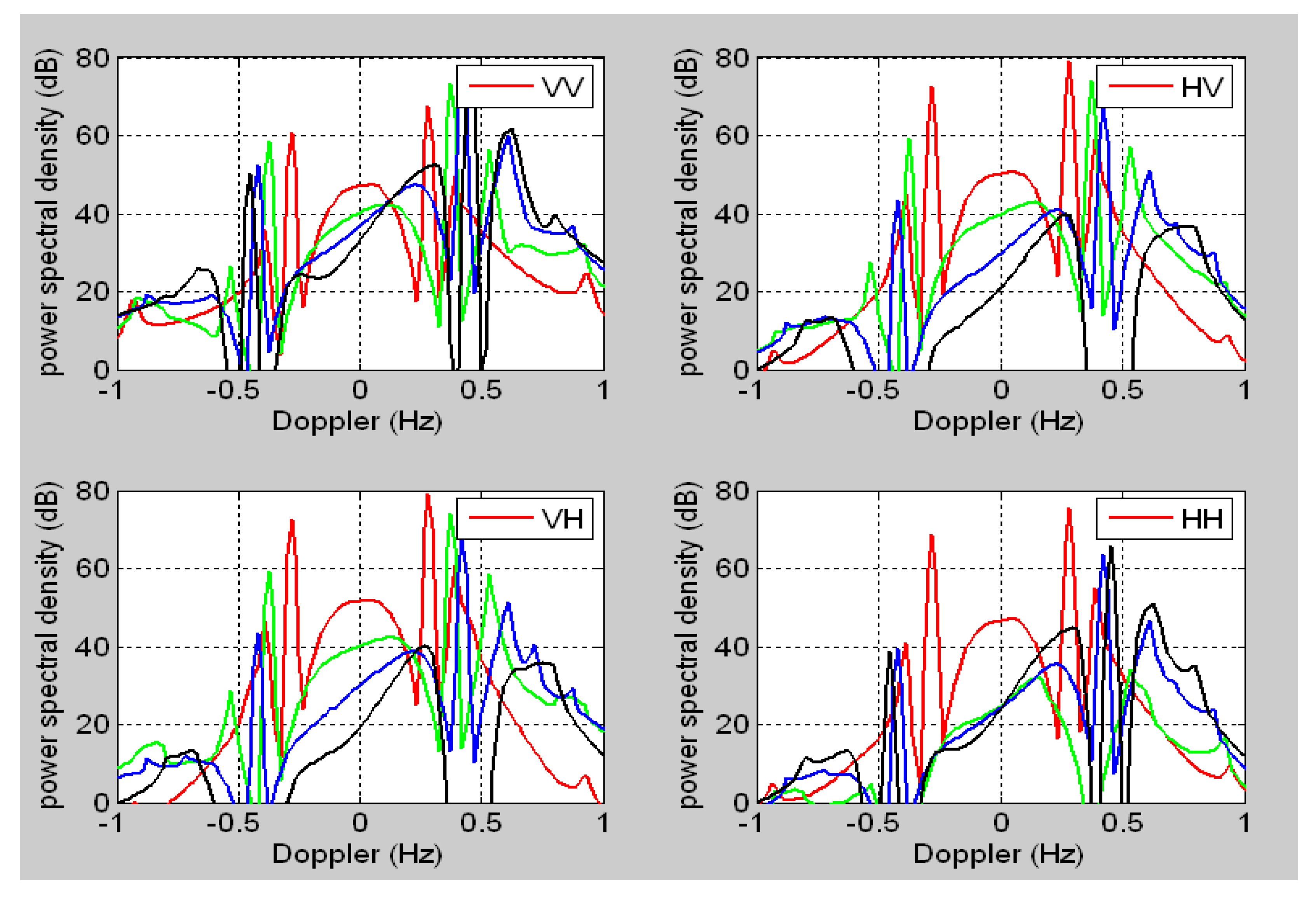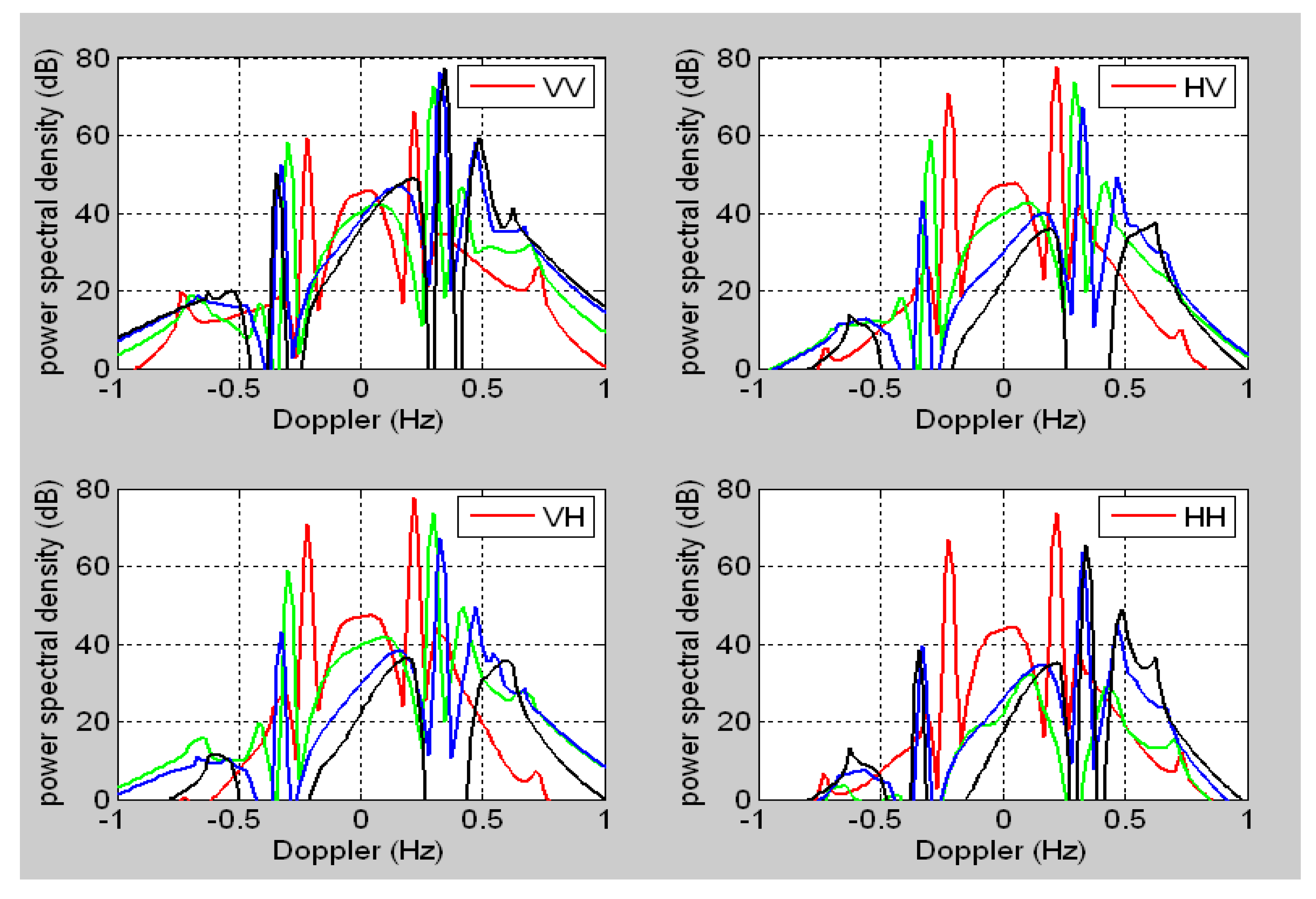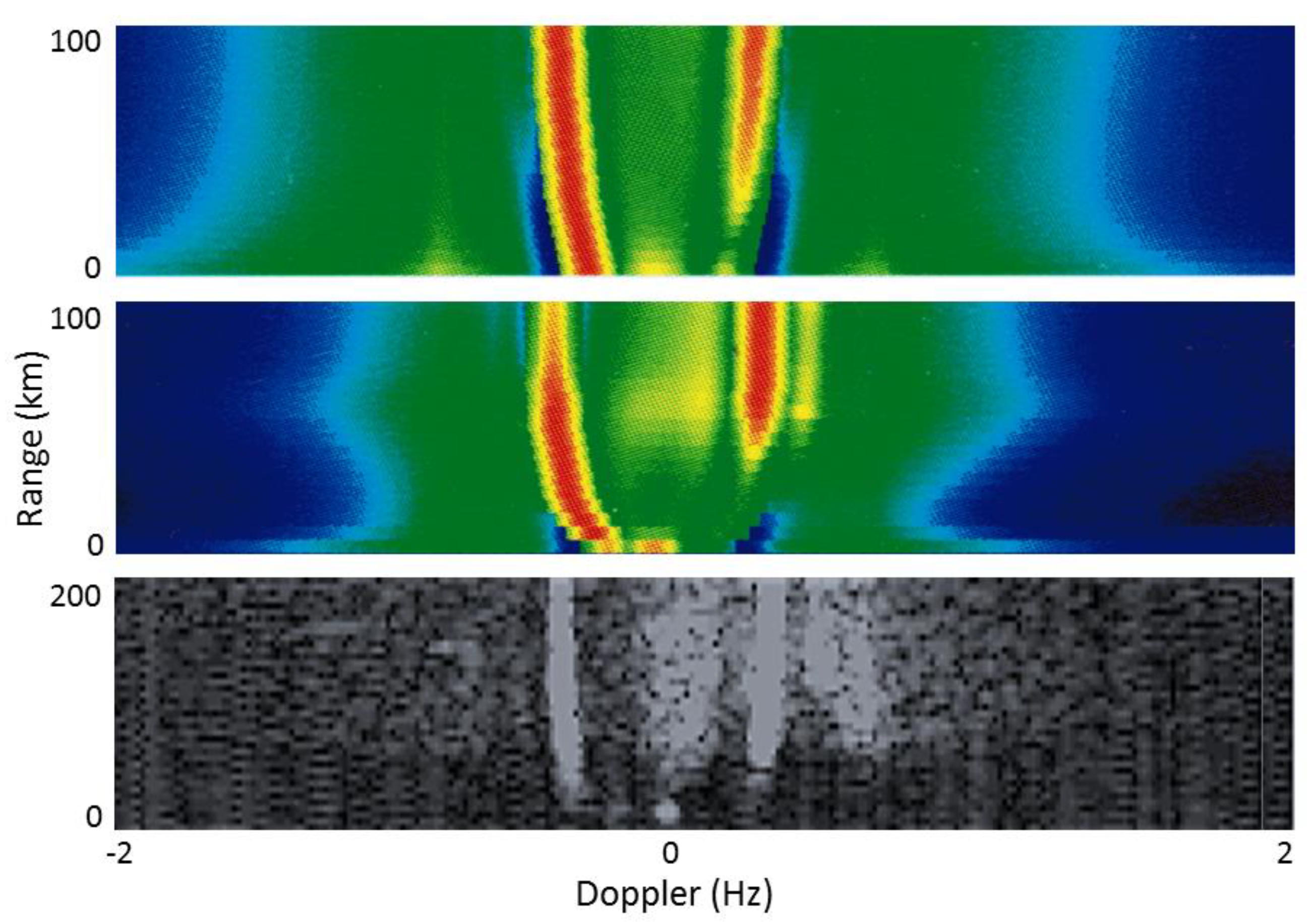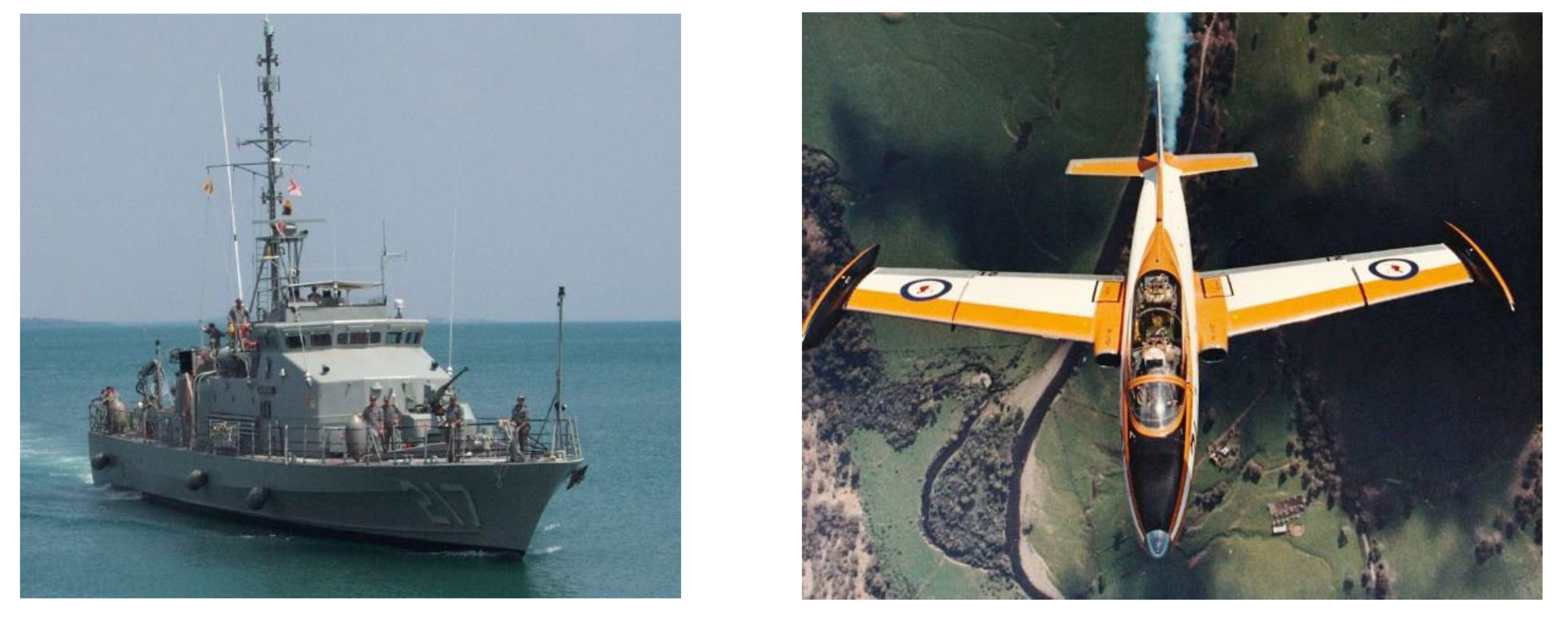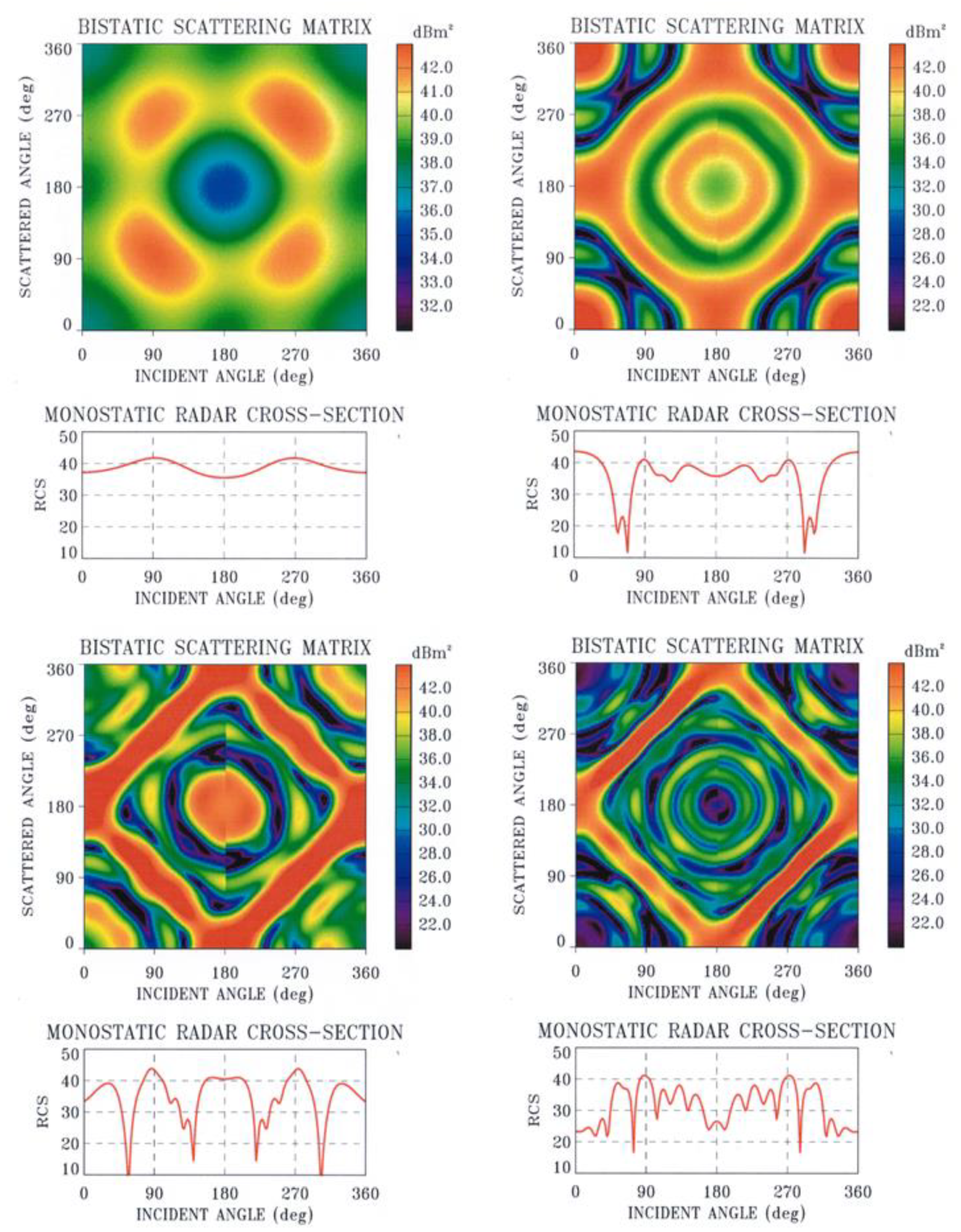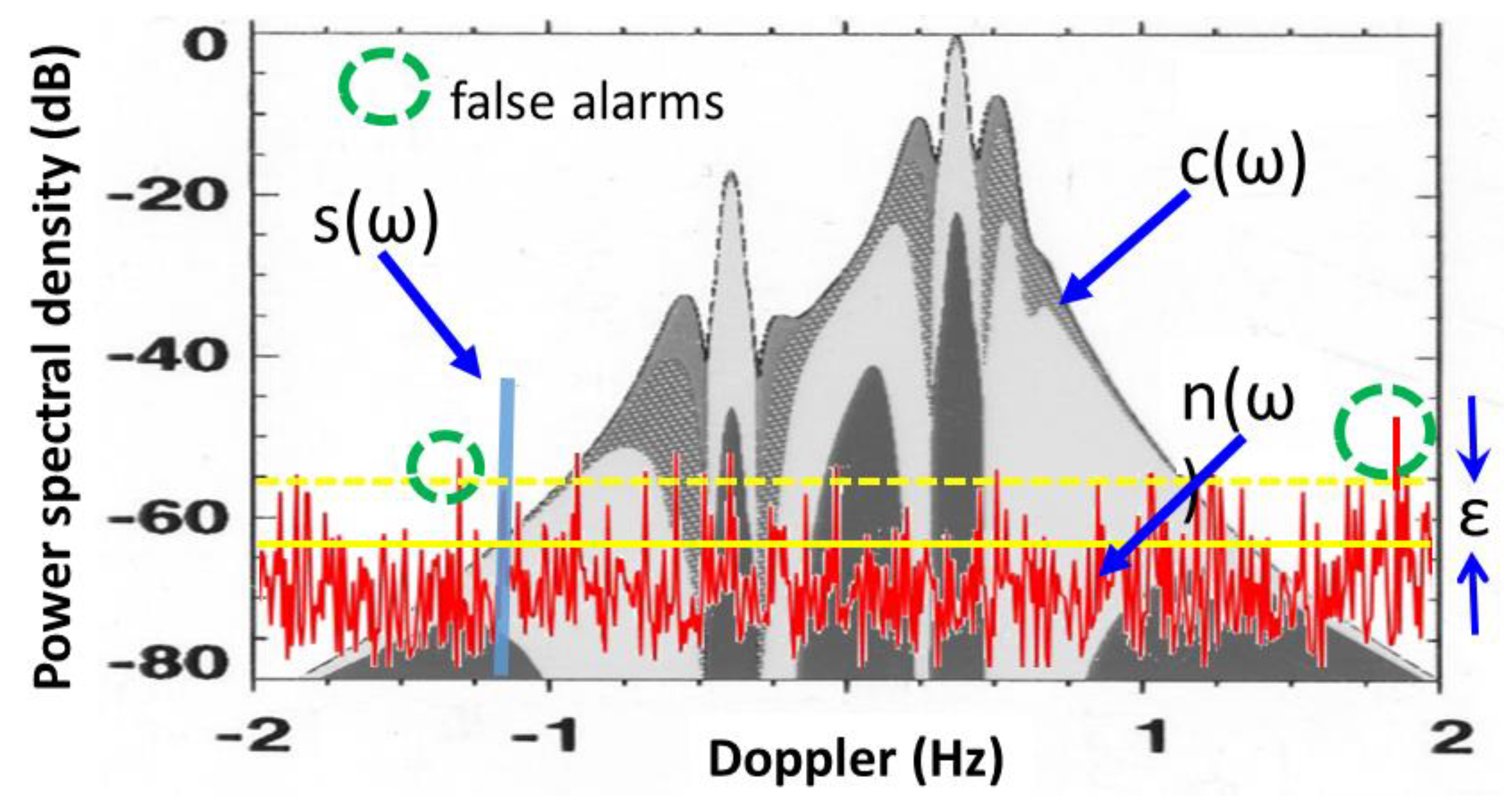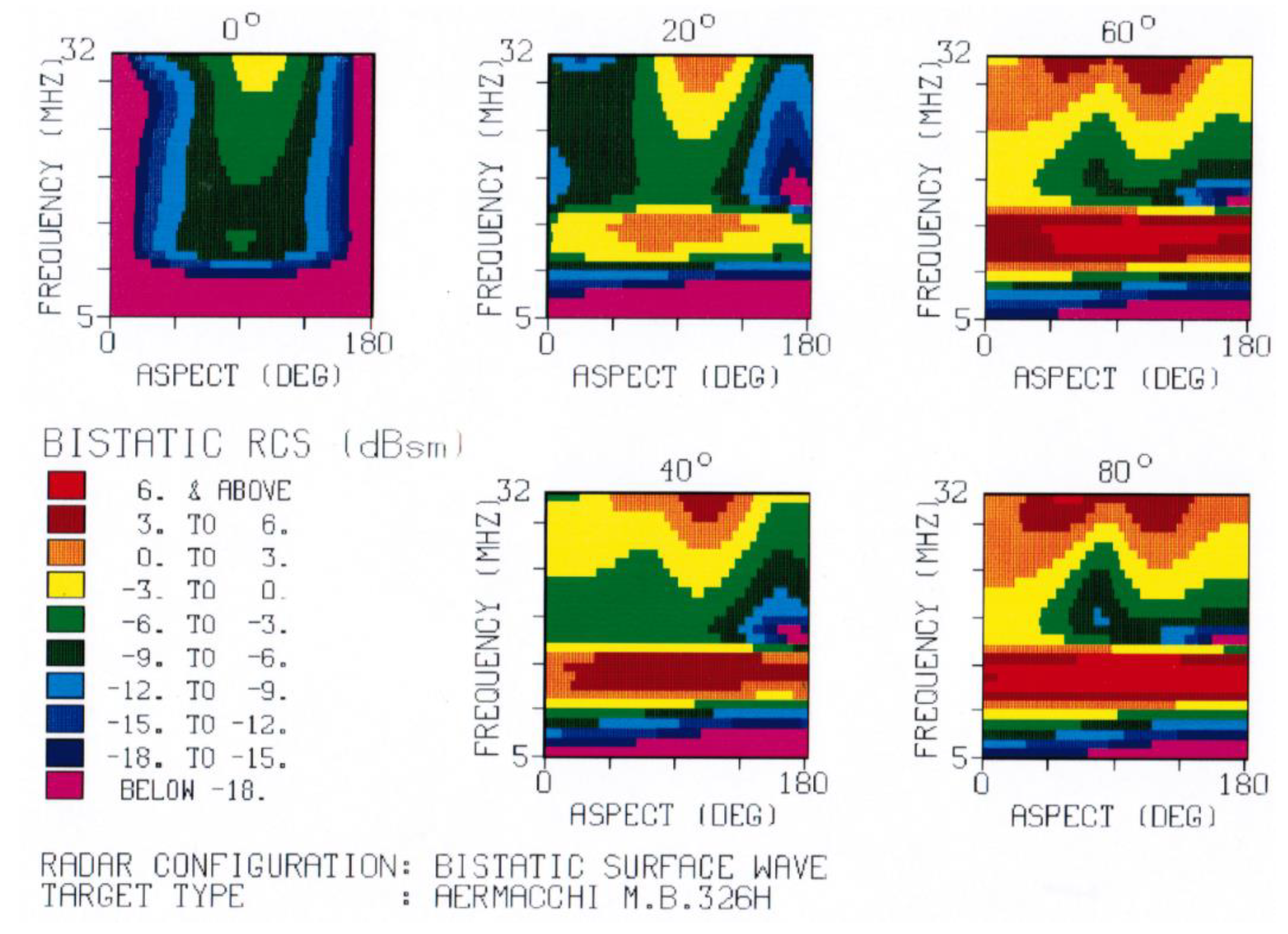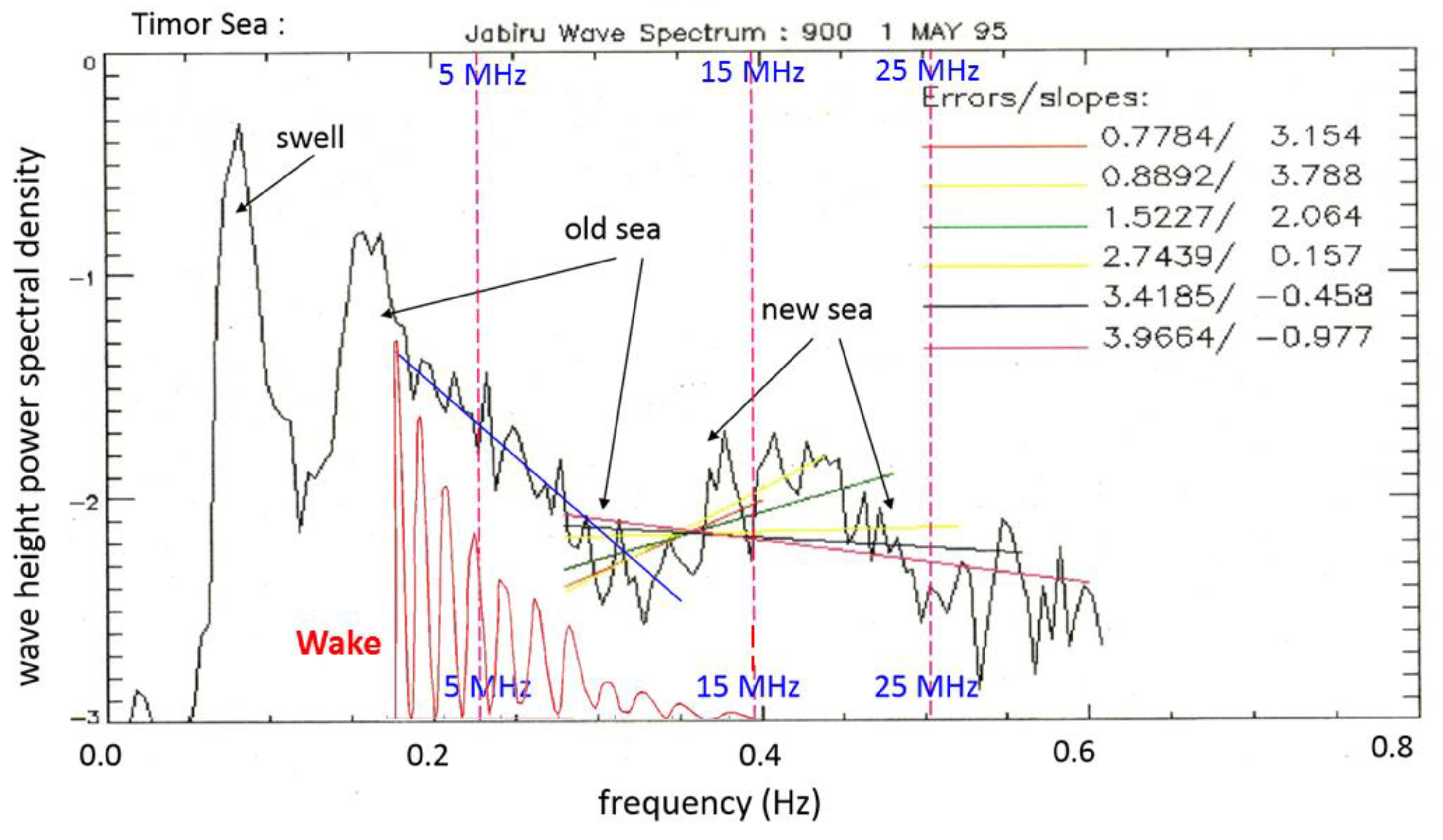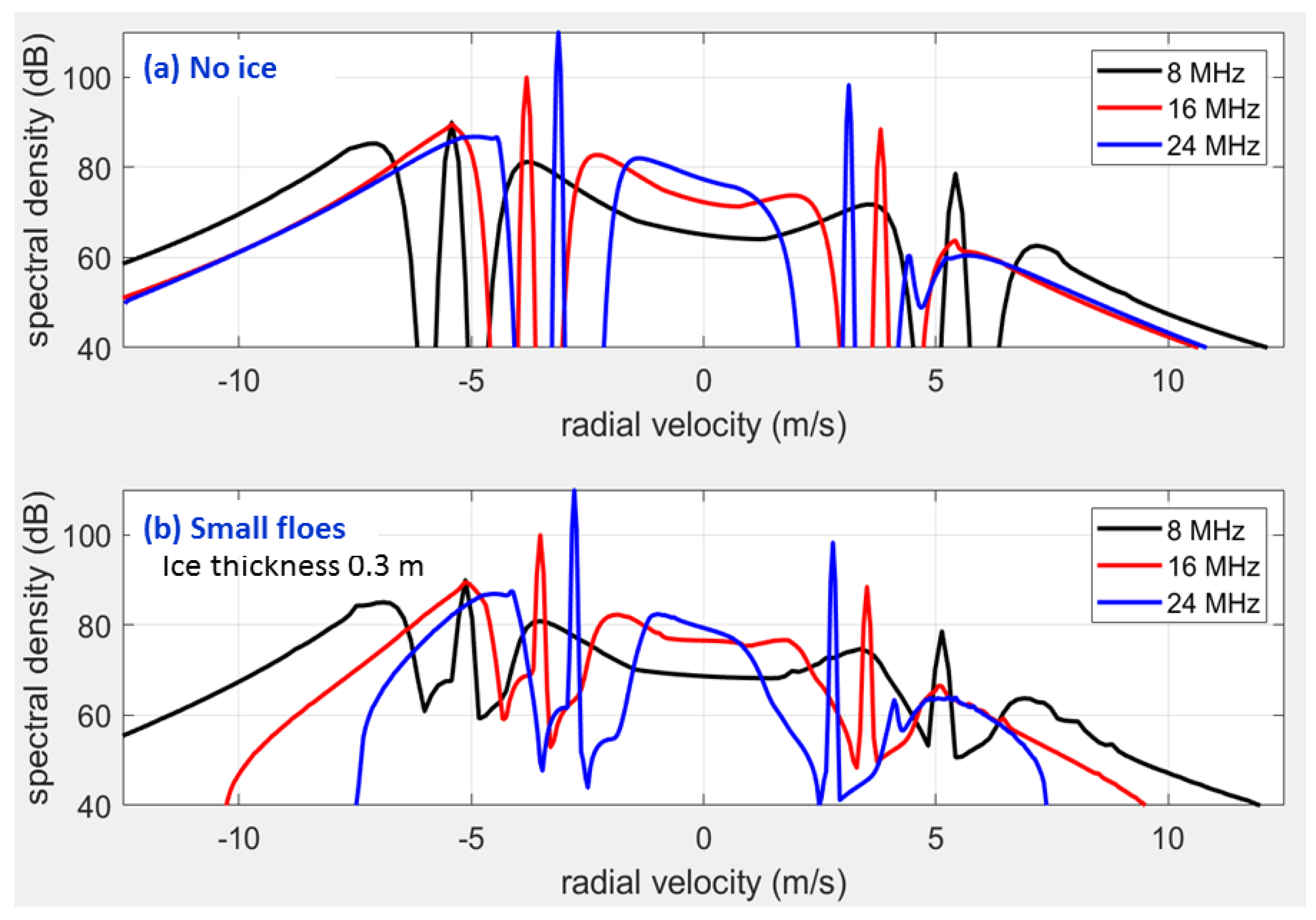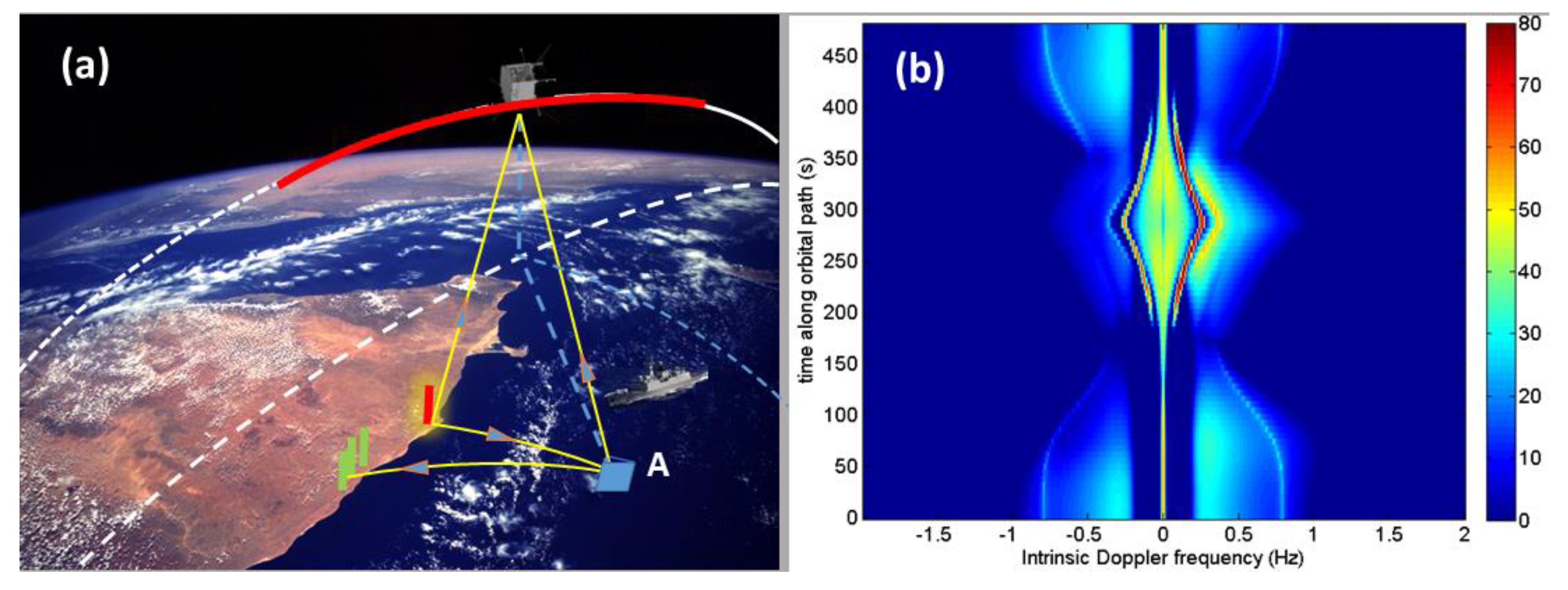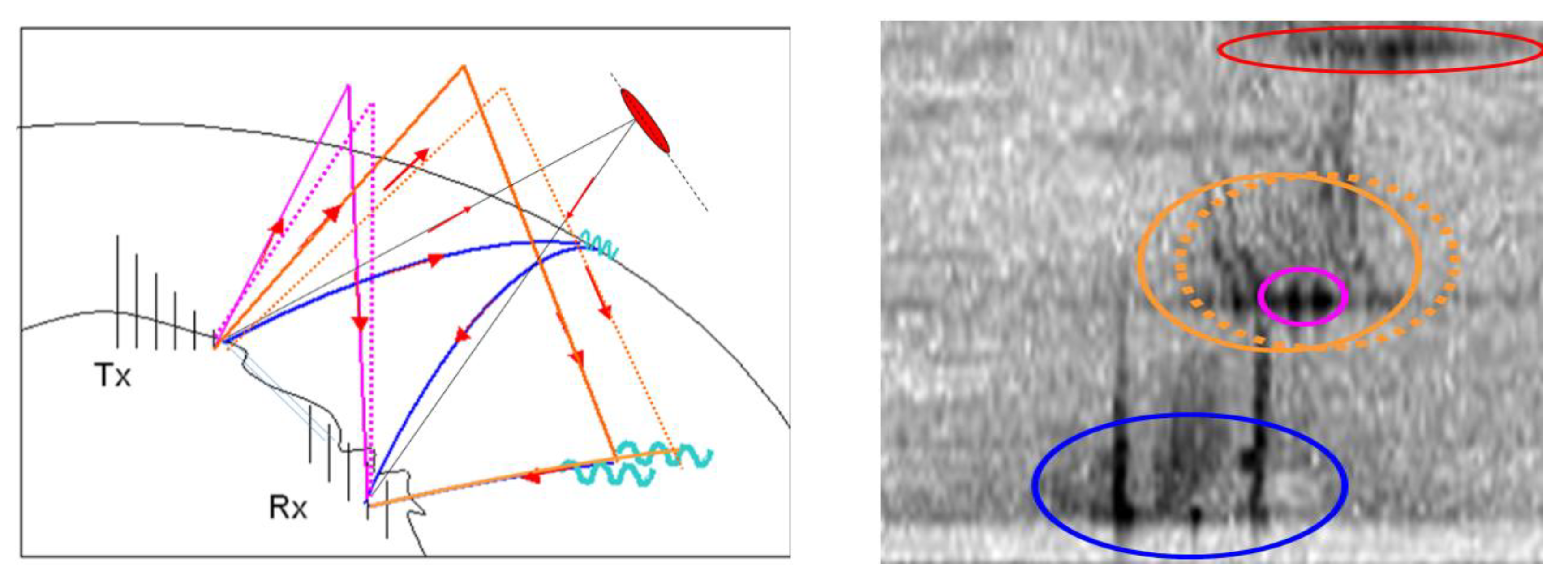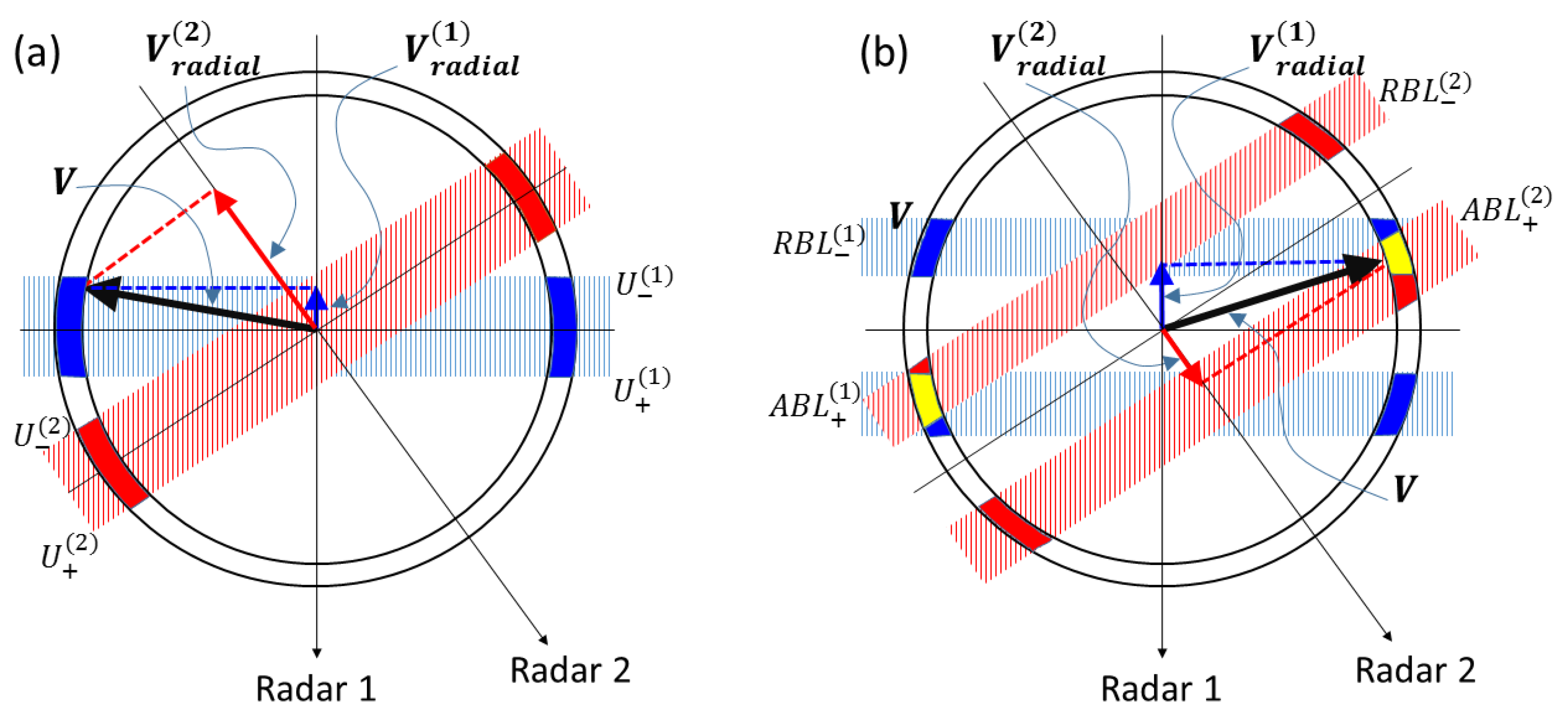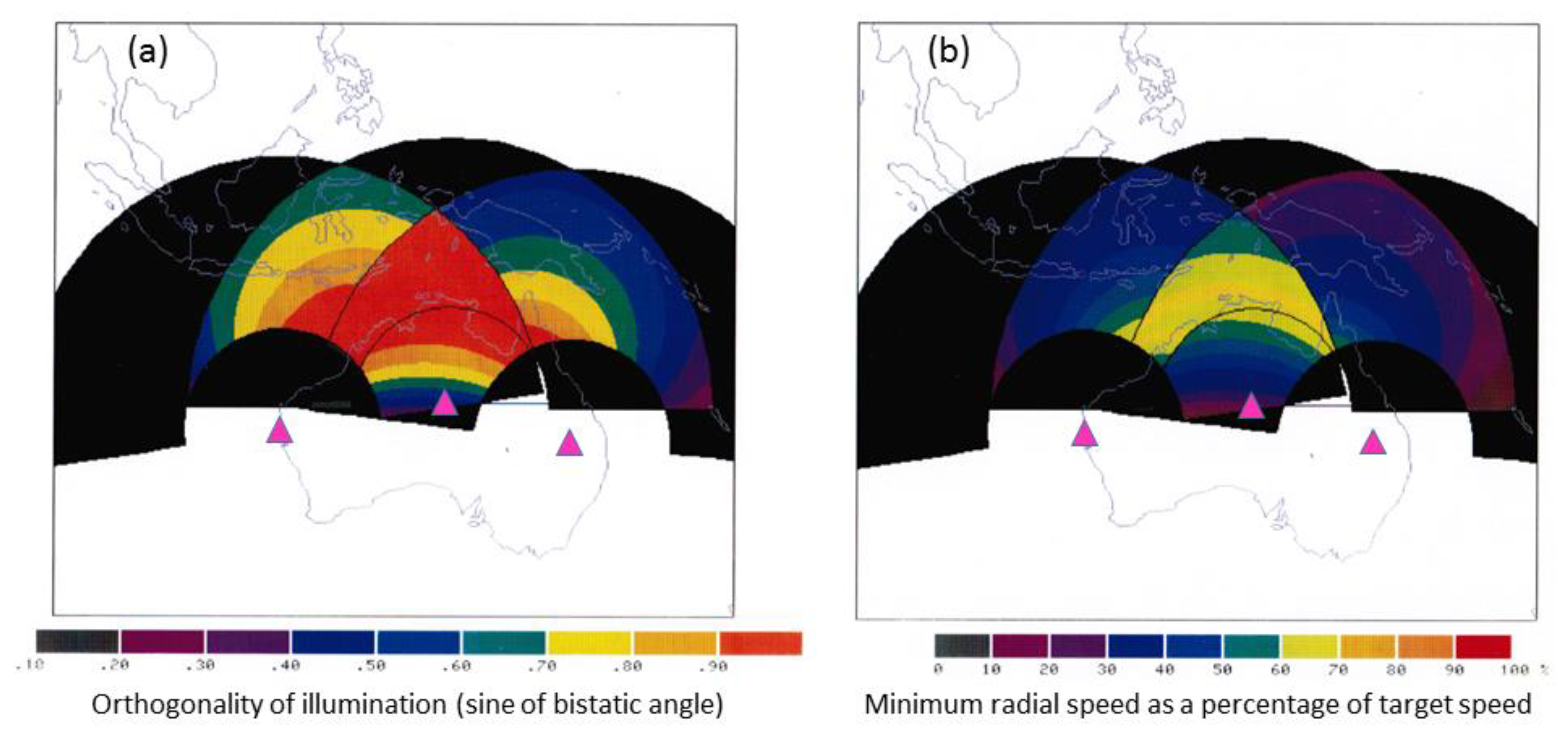1. Introduction
Remote sensing of our geophysical environment by means of radio waves in the HF band is now a truly global activity, with decametric radars operating in scores of countries, and on every continent [
1]. In a number of instances, international collaborations facilitate the integration of the outputs from individual radars to yield regional or even basin-scale products, thereby increasing the quality, diversity, and utility of the derived information [
2].
The overwhelming majority of these radars operate in the conventional monostatic configuration, with the transmitting and receiving systems collocated or closely spaced (the term quasi-monostatic is often used in this case). This simple geometry has obvious advantages in terms of cost, siting requirements, communications, maintenance, signal processing, and echo interpretation, and has been adopted by HF radars exploiting line-of-sight, surface wave, and skywave propagation modalities.
All these considerations notwithstanding, in some circumstances, there can be compelling reasons to implement bistatic configurations, often defined as geometries in which the separation between transmitter and receiver is comparable with the range to the zones being interrogated. Factors that can drive this decision include energy budget, desire to exploit hybrid propagation modes, scattering characteristics of the targets of interest, properties of the clutter, survivability, and covertness. Bistatic HF radars with very specific missions have been deployed since the 1960s, predominantly in defense applications, but the convenience of monostatic designs and the adequacy of their standard remote sensing products have tended to discourage wider adoption of bistatic configurations.
Once we allow for the separation of transmit and receive facilities, many possible configurations emerge. Each of these subsystems can be located on land, at sea, in the air, or even in space, with a range of propagation mode combinations possible for the signal paths from transmitter to target and target to receiver. Of these, line-of-sight, ground wave (we shall use the term
surface wave throughout this paper, though strictly it refers to only one component of the total field−the dominant one at over-the-horizon ranges), and skywave modes are by far the most common, though more exotic propagation mechanisms have been explored.
Figure 1 presents a taxonomy of the main configurations; those that are understood to have been implemented, or at least reached the advanced design and experimentation phase [
3], are indicated by the colored dots (E. Lyon, personal communication, May 19, 2015).
An obvious generalization of these single radar configurations is the deployment of multiple radars to interrogate a common area of interest. This is the standard modus operandi of current mapping HF surface wave radars (HFSWR) such as the CODAR SeaSonde [
4] and the Helzel Messtechnik WERA [
5], where two or more measurements of radial velocity are combined to yield a resultant vector. We note that measurements from these two distinct radar designs—based on direction-finding and beam-forming, respectively—can be combined to expand network coverage and reduce down-time [
6]. Skywave radar networks with overlapping coverage have been operational in Australia (JORN) [
7] and the United States (ROTHR) [
8] for decades; not surprisingly, there are many issues to be taken into account when designing such configurations [
9,
10]. The term stereoscopic has been used to describe these multi-monostatic configurations; other applications include ship target dynamic signature analysis and excitation of nonlinear scattering mechanisms.
Another generalisation is the use of relay stations; that is, combined receive–transmit facilities that acquire the signal radiated by the primary radar transmitter, amplify it, possibly with additional modulation, and then reradiate it, thereby extending the range of the system or facilitating other radar functions.
This diverse array of system geometries offers many opportunities for remote sensing. In particular, the ability to extend the range of Bragg resonant scattering to lower wavenumbers opens the way to observing some environmental phenomena to which monostatic radars are insensitive. One example of this is the determination of sea ice parameters. Short sea waves are rapidly attenuated as they enter the marginal ice zone; only long waves penetrate to useful distances into the ice field. The sea ice properties are encoded in the radar Doppler spectrum, most visibly in the first-order peaks [
11]. For a monostatic radar to observe these peaks, it would need to operate at a very low frequency, below those employed by present-day HF radars, but a bistatic geometry enables the returns from longer waves to be measured. Another example is the investigation of the physics of the ionosphere via analysis of impressed phase modulation [
12,
13], wavefront distortion [
14], and polarization transformation [
15] of oblique (bistatic) radar reflections; these are largely inaccessible to monostatic radars.
In this paper, we explore many of the issues that arise with bistatic HF radar configurations, basing our analysis on the formal radar process model presented in the following section. After examining the implications for the component elements of the radar observation process, we proceed to describe some specific radar missions that benefit from the physics of bistatic scattering and/or hybrid propagation modes. The term hybrid is often applied to configurations where the outbound and inbound propagation modalities are different; that is, they lie off the diagonals in the boxes of
Figure 1. Along the way, we describe and illustrate some practical techniques that can serve as a guide to bistatic HF radar design and deployment. In particular, we look at the problem of site selection, a challenge that is compounded by the need to address multiple radar missions.
2. The General Radar Process Model
The radar process model formulation first introduced in [
16] is ideally suited for our purpose as it makes explicit the temporal sequence of the signal trajectory and of this in mind, and noting that multizone scattering in the course of signal propagation (see below) has been observed to be significant for both skywave and surface wave HF radars [
17,
18], the formulation of the radar process is expressed as a concatenation of operators,
where
represents the selected waveform,
represents the transmitting complex, including amplifiers and antennas,
represents propagation from transmitter to the first scattering zone,
represents all scattering processes in the j-th scattering zone,
represents propagation from the j-th scattering zone to the (j+1)-th zone,
denotes the number of scattering zones that the signal visits on a specific route from the transmitter to the receiver,
denotes the number of external noise sources or jammers,
represents propagation from the i-th noise source to its first scattering zone,
denotes the number of scattering zones that the i-th noise emission visits on a specific route from its source to the receiver,
denote the maximum number of zones visited by signal and external noise, respectively,
represents the receiving complex, including antennas and receivers,
represents internal noise,
represents the signal delivered to the processing stage.
If the transmitter and/or receiver are in motion, as with shipborne radars, for example, a slight generalization is in order. Adopting the frame-hopping paradigm, we insert Lorenz transformation operators:
and
to take kinematic effects into account.
The effective design of bistatic HF radar systems requires decisions that involve all the terms in the process model, singly, pairwise, or collectively. Ultimately, the design problem is one of optimization; that is, finding the best combination of siting and radar parameters as measured by performance over the set of missions to be addressed. In general, this is a multi-objective problem as radars may be designed to perform air and surface surveillance as well as remote sensing of one or more geophysical variables. Later in this paper, we will describe tools for achieving this optimization, but first we examine some of the most important considerations associated with the individual operators.
3. Consequences of Bistatic Geometry on the Radar Process Model Operators
3.1. Waveform
Most HF radars nowadays employ a variant of the linear FMCW waveform, ranging from a continuous signal, through interrupted FMCW, to FM pulses with a low duty cycle. Interrupted versions include notched sweeps as well as frequency-hopping and spaced sweep formats. In addition to the FMCW class, phase-coded pulse waveforms can still be heard. For most of these options, MIMO (multiple input, multiple output) implementations are possible.
When one moves from monostatic or quasi-monostatic to the bistatic case, several considerations need to be kept in mind. First, the separation of transmit and receive facilities greatly reduces the problem of self-interference, thereby expanding the waveform parameter space. For the moment, we set aside the case where radars in a stereoscopic configuration are sharing a common transmission frequency band. Second, it is well known that range-folded echoes pose a serious hazard for monostatic radars, arising from the combination of long-range propagation of HF radiowaves and the abundance of ionospheric and terrestrial scatterers. As illustrated in
Figure 2, bistatic configurations offer a greater freedom with choice of waveform repetition frequency because the range-ambiguous zones of illumination are displaced from those of the receiving system. We note here that the use of non-repetitive waveforms is another tool for reducing this threat, though few HF radars presently employ such signals.
Yet, even bistatic systems are advised to take account of the far-range illumination pattern as the magnitude of unwanted environmental echoes may be sufficient to disrupt through receiving array sidelobes. Third, an associated problem is the prospect of round-the-world (RTW) propagation—in powerful HF skywave radars, signals have been observed after three transits around the Earth. Of course, for low-power radars, background noise will almost invariably swamp RTW returns. Fourth, when pulsed waveforms are used, the fact that bistatic geometry couples time delay to angle-of-arrival may require that one implements a pulse-chasing capability [
19], with its attendant penalties. Fifth, the spatial properties of bistatic resolution cells are well-known [
20], but less attention has been paid to what we might call the Doppler sensitivity,
, where
is the Doppler shift and
is the target speed. To quantify this, recall that the bistatic Doppler shift of a target with velocity
at location
x given by
with
the bistatic angle and
β the target heading relative to the bisector axis; hence,
The Doppler sensitivity loss factor is one component of the price we pay in return for whatever advantages we can extract from employing a bistatic configuration.
3.2. Transmitting Facility
Central to the design of the transmitting facility is the orientation of the illumination pattern relative to that of the receiver. For any given location
in the common zone, the radiated signal amplitude is proportional to
, or simply
for HFSWR. The radar designer has the option to orient the maximum directive gain of the transmitting array towards that region in the receiving facility’s field of view, which has been accorded the highest priority. More generally, for signal-to-noise dominated missions, we can formulate the HFSWR orientation problem as one of maximizing the figure of merit (FOM) of the priority-weighted pattern,
where
is the nominal boresight orientation of the transmit array and
represents the priority weighting over the receiver processing zone
R.
A complication that arises with clutter-related missions of HFSWR is the phenomenon of multiple scattering [
21,
22]. This can corrupt the received echoes when the sea state is significant, so in addition to providing sufficient incident power density, a sophisticated transmit antenna design would attempt to minimize the associated contributions, relative to the echoes received via the primary propagation path. To do this requires a regional wave climatology but is otherwise straightforward.
3.3. Propagation
The involvement of distinct outbound and inbound propagation paths has major ramifications for HF skywave radar, with a lesser, though still observable, impact on HFSWR. For monostatic skywave radars, frequency management systems probe the ionosphere and determine (i) the frequency band providing adequate power density in the target zone, and (ii) some measure of the quality of the propagation channel [
23]. With bistatic configurations, the frequency that works best for propagation from transmitter to target zone will often be poor for propagation from target zone to receiver; in this case, the optimum frequency will effect a compromise, and may, on occasion, take a highly non-intuitive value.
In order to quantify the impact on performance, we can exploit the geometrical congruence of a single bistatic signal path and two monostatic paths [
24].
Figure 3 shows the concept underlying this technique.
The first emission travels from the monostatic radar at location X to the target zone at relative coordinates
, scatters, and returns to the radar. Using a scalar form of (1) for notational simplicity, the complex amplitude of the received signal is given by
so the received power is
. Now, write
and
. We can identify
as the one-way propagation amplitude loss factor for the outbound signal and
as the corresponding amplitude loss factor for the inbound signal. Power loss factors are then simply
and
, and the propagation power loss for the two-way process is
.
A second observation is then made in a different direction, to a target zone at coordinates
,
with two-way propagation loss
, as shown in
Figure 3a. Now imagine that there is a transmitter at location
and a receiver at
as shown in
Figure 3b; that is, a bistatic radar configuration interrogating the region previously occupied by the monostatic radar. The complex amplitude for this case is given by
where we have taken the orientation of the imagined arrays to be parallel to those of the monostatic system. Now, the propagation paths satisfy reciprocity,
and
. Further, the gain patterns of the transmit and receive arrays are strongly determined by the array apertures but vary only weakly with steer angle over moderate departures from boresight. Thus, we can write
and
where
for a radar whose arrays each steer over a 60° arc. Substituting in (9), and invoking (7) and (8),
The magnitudes of and can be estimated by inversion of the respective Doppler spectra, or even approximated at zero cost by assuming fully developed seas—typically valid for HF frequencies above 15 MHz. The steer directivity loss factor so its effect is insignificant compared with the variability of the other terms. Thus, from measurements of the returned clutter power from monostatic observations and , we can predict the echo power for the bistatic configuration observation for an arbitrary specified scattering coefficient . One point to note here is that we have simplified the discussion by ignoring the polarization domain; this is not a significant issue for HFSWR and can be avoided in the skywave radar case by a combination of spatial and temporal averaging.
HF skywave radars routinely collect backscatter ionograms (BSI) over the arc of coverage, typically out to a range of 5000–6000 km, so there is a wealth of propagation data available from which to derive statistical predictions that can be used for bistatic system design. A representative BSI is shown in
Figure 4, with the instantaneous range depth marked for a nominal radar frequency of 15 MHz. Assuming a slow variation with azimuth, both
and
need to lie between 1400 km and 2300 km.
Figure 5 shows an instance of an inferred sub-clutter visibility (SCV) map computed for a representative radar network (the monostatic input data are real but not obtained from these radars).
While it is necessary to exceed some target-specific threshold of power density in order to achieve detection, for slow-moving targets, such as ships, that may not be sufficient. The presence of multimode propagation and phase path fluctuations associated with field line resonances and other ionospheric disturbances can blur the Doppler spectrum of the radar returns and thereby obscure the desired echoes. This raises the question: Can we extend the analysis discussed in the preceding paragraphs so as to obtain statistical information on the phase path modulation spectrum over bistatic paths?
The answer is a qualified ‘yes’. Techniques to estimate and then correct for phase path variations have been developed and installed in operational systems since the 1980s [
12,
13] so the individual phase path modulation time series are available for each leg of the synthesized bistatic path. A rudimentary synthesis approach would simply concatenate the phase modulation histories, then halve them, but that could introduce Doppler spreading due to phase discontinuity at the junction point. A superior method involves first phase-shifting the second half to ensure phase continuity and then applying a conjugate taper weighting around the junction to affect a smooth first derivative.
This approach works for the most important class of fluctuations, where the spatial scale is of the order of 10
2 km, and latitude-dependent, being linked to the geomagnetic field line resonances (FLR) that are observed as micro-pulsations at ground level. At times, other dynamical processes cause fluctuations over much smaller spatial scales.
Figure 6 illustrates these two types of modulation: Each frame shows the measured phase fluctuation time series over a two-way skywave channel. In
Figure 6a, the modulation estimated from the echoes originating in four individual range cells spaced over a range depth of about 150 km shows a high degree of spatial correlation, suggesting that the outbound and inbound legs of a bistatic skywave radar observation would experience related modulation sequences. In contrast, when other types of modulation prevail, the paths can experience uncorrelated and often more erratic modulations. In
Figure 6b, the cells shown are spaced over a total of only 20 km, yet the modulation patterns are quite distinct. In both cases, we can construct a simulated bistatic path resultant modulation sequence, using the ideas of the previous paragraph, but only for the former type can we hope to associate the observed modulation with the known properties of geophysical wave processes in the ionosphere.
It is perhaps apposite to note here that an operationally significant relative of the problem of joint path optimization is the converse—the selection of frequencies that guarantee strong propagation over one path and little over the other for the same radar frequency. Such a bistatic configuration has direct relevance to the detection of nonlinear target echoes and the ability to suppress sea clutter by many tens of dB. A description of this scheme can be found in [
25].
3.4. Scattering
The ability of HF radar to address a wide range of missions brings with it the need for mathematical techniques for computing the radar signatures of the diverse phenomena involved. Bistatic HF radar has been implemented in the form of operational systems since the 1960s but, for most of its history, practice has dominated theory. We can perceive four main lines of development in HF scattering theory: One for the ocean surface, one for plasma formations in the ionosphere, one for land surfaces, and one for discrete targets such as ships, aircraft, and missiles.
3.4.1. Scattering from the Ocean Surface
The perturbation theoretic approach of Barrick [
26], building on the Rice theory for scattering from static rough surfaces [
27], has served as the cornerstone of HF radar oceanography for the past five decades. Quite a few generalizations of the Barrick theory have appeared over the years (e.g., [
28,
29,
30]), as well as a different approach [
31] based on the Walsh theory for scattering from static surfaces [
32] and extended by Gill and co-workers (e.g., [
33,
34,
35,
36]). As ocean applications of HF radars dominate, and as bistatic configurations become more widespread, it is hardly surprising to find an emerging literature of papers that apply the fundamental theories to particular circumstances. As a guide, we have tabulated some of these bistatic scatter papers against key parameters: (i) The perturbation order of the approximation, (ii) the scattering geometry, (iii) whether platform motions were taken into account, (iv) the polarization states addressed, and (v) the hydrodynamic dispersion relation employed. This file is available from the author.
The general expression for the scattered field in
space, to second order, has the form
In this equation, the dispersion relation appears as
; it is this function that determines the contours of integration that yield the Doppler power spectral density. Recent investigations of HF scatter from sea ice motivated the development of a computational model able to solve for any explicit dispersion relation [
11,
37]. Expressions for the kernel functions
and
can be found in the cited literature, while the Fresnel reflection coefficient
is a function of the water temperature and salinity.
Viewed diagrammatically in the spatial frequency domain, as shown in
Figure 7, an important feature of bistatic Bragg scattering becomes evident, namely the smaller modulus of the resultant wave vector increment, shown in black. At first order, this means that longer ocean waves can be measured directly, while at second order, it means that a broad angular spread of the shorter waves in the participating wave field favors the scattering contributions.
It is instructive to see the form of the Doppler spectrum as a function of the bistatic geometry for particular situations and as a function of various parameters. First, we present
Figure 8, taken from [
18], which shows, at a most basic level, how a particular seastate modulates the frequency of the scattered signal depending on the scattering geometry: Back scatter, forward scatter, side scatter, or up scatter. In this example, only the VV (vertical in, vertical out) element of the polarization power scattering matrix is presented.
Next, in
Figure 9,
Figure 10 and
Figure 11, we show the full polarization power scattering matrix for three different radar frequencies, in each case plotting the spectrum for four different bistatic skywave scattering geometries, at a fixed sea state. Here, 180° corresponds to backscatter, i.e., monostatic geometry. The vertical angles of incidence and reflection are 40° in all cases.
Finally, in
Figure 12, we present a range-Doppler map measured with a bistatic HFSWR, along with two modelled range-Doppler maps computed for scattering geometries close to that used for the measurement.
3.4.2. Scattering from Ships and Aircraft
Although target detection was once the province of HF radars deployed only for national defense, many low-power remote-sensing radars are now addressing this mission, primarily focusing on ship detection. Modelling HF radiowave scattering from ships and aircraft has been carried out for many decades by means of computational electromagnetic codes. Early work was almost exclusively carried out using the method-of-moments code NEC, but nowadays, other software packages such as FEKO, CST Studio, and HFSS are widely used, along with more advanced in-house codes. Here, we illustrate the general characteristics of bistatic HF radar cross sections (RCS) of ships and aircraft with results computed for the Fremantle-Class patrol boat 42 m in length, and the Aermacchi MB 326H aircraft, wingspan 10.6 m. These platforms are pictured in
Figure 13.
A format developed to present bistatic HF radar cross section is shown in
Figure 14. The figure shows the predicted bistatic RCS of the Fremantle Class patrol boat, evaluated at four different radar frequencies. More precisely, it shows the squared magnitude of the VV component of the polarization scattering matrix, but we will use the term RCS where no confusion is likely. This format uses columns to index the azimuthal angle at which the radar signal is incident on the target and rows to index the azimuthal angle of departure or scattered angle. In this example, the elevation angle is set to 0° (vertical angle of incidence=90°), which closely approximates the field structure for HFSWR. Below each panel showing the bistatic RCS is the monostatic RCS, i.e., the trailing diagonal of the matrix.
For detection, we require that a ship echo exceed the clutter and noise power in the same Doppler bin by some margin
ε; that is, there exists
ω ∈ [−Ω, Ω] such that
where
s(
ω),
c(
ω), and
n(
ω) are the target, clutter, and noise power spectral densities. This situation is illustrated in
Figure 15, where a nominal target echo is superimposed on Doppler spectra evaluated for four different sea states.
The rich structure of the RCS patterns reveals the potential for exploitation by both the radar designer selecting sites for his transmit and receive systems, and the vessel seeking to minimize its detectability, in concert with other strategies that a clandestine mission might exploit. As we have seen in the previous section, the option of utilizing a bistatic configuration gives us an extra degree of freedom for ‘controlling’ the clutter spectrum.
While aircraft detection has seldom been a priority for HFSWR, it is certainly an established capability.
Figure 16 uses a different format to show the VV RCS of the Aermacchi MB 326H as a function of azimuth (i.e., aspect) and radar frequency. The five panels correspond to different bistatic angles, namely, 0° (i.e., monostatic), 20°, 40°, 60°, and 80°. As aircraft move at speeds that carry them rapidly across typical HFSWR coverage, presenting a changing aspect, a distinctive temporal variation of echo strength can be observed, potentially useful for target classification.
3.4.3. Scattering from Slow-Moving Vehicles
Another example of the benefits of bistatic scattering at HF is the improved skywave detectability of slow land-based vehicles. Measurements of the spatial spectra of two types of terrain are presented in
Figure 17a,b. These are based on very high-resolution digital elevation maps, covering thousands of square kilometers, with postings at 5 m spacing.
From
Figure 17a, corresponding to a hilly region, the surface elevation
follows a one-dimensional power law with
while, for the relatively flat region treated in
Figure 17b, the power law behaves as
. It is not unreasonable to regard these exponents as rough limits on typical terrestrial surfaces when the vegetation density is light. Now, the local HF bistatic scattering coefficient for natural land surfaces can be modelled with first-order small perturbation theory, taking account of the dependence of the scattering coefficient on the local angle of incidence, weighted by the medium-scale slope probability density function. To proceed, we facet the resolution cell into n patches that are planar in the mean, but with small scale roughness,
where the patches over each of which a local normal vector is defined are obtained by faceting the surface using a local flatness criterion.
The general expression for the first-order bistatic scattering coefficient takes the form
where
and
index the incident and scattered polarisation states and the function
accounts for the polarisation-dependence. To apply this to the tilted facets, we need only to transform to local coordinates via the appropriate rotation matrix, apply the scattering formula, then perform the inverse transformation.
There are two important considerations here that relate to the merits of bistatic scattering geometry. First, substituting the measured power laws of the land surfaces in the scattering formula, and writing the expression for the case of
for clarity, we find
where
. There are two features of interest here. The first is the slow fall-off of the power spectrum, which implies that the scattering coefficient will increase with radar frequency, so clutter can be reduced by operating at lower frequencies. The other feature is the variation of the scattering coefficient with bistatic angle. The case of the VV element of the polarization scattering matrix is plotted in
Figure 18 over a typical range of bistatic angles. It is evident that by employing a moderately bistatic scattering geometry, the land clutter can be reduced by a factor of 2–3. As spectral leakage is a key limiting factor in slow land target detection, this is a significant gain in detectability.
3.4.4. Scattering from Ship Wakes
The possibility of detecting ship wakes was recognized in the 1970s, but early studies focused on first-order scattering, which is critically dependent on radar geometry and frequency and hence not a practical solution. The development of a second-order theory [
38,
39,
40] has opened the way to a meaningful capability, but here too, careful consideration of the radar geometry and frequency is required to approach optimum sensitivity.
According to this theory, the wake signature depends not only on the vessel, it is also a function of the ambient sea state, so no simple assertion of optimality of one or other configuration can be made. Nevertheless, extensive modelling has shown that bistatic geometries routinely emerge as optimal solutions.
One indication of the possible advantage of bistatic geometry can be seen from
Figure 19, showing a measured omni-directional wave spectrum from the open sea, on which is superimposed the corresponding spectrum for a ship wake. As the annotations reveal, the wake components are concentrated at low frequencies (and hence wavenumbers) for which monostatic first-order Bragg scatter at HF is not available, but at a bistatic angle
the resonant wavenumber is decreased by a factor
.
3.4.5. Scattering from Ice-Covered Seas
There have been many oceanographic applications of HF radar but with a sole exception, they share the attribute that the dispersion relation assumed to govern the sea surface dynamics is that corresponding to a free water surface. In almost all applications, the general form of the dispersion relation,
is approximated by the inviscid, deep-water limit,
though several studies have considered the shallow water case [
29,
41,
42].
In the polar regions, the sea surface freezes and a complex ice structure forms over millions of square kilometers, varying dramatically with the season. This ‘skin’ is not completely rigid; it possesses mechanical properties that allow waves from the open sea to penetrate the ice zone, causing the surface to undulate as they propagate. In order to measure the surface motions and, from the Doppler signature, infer the structural and mechanical properties of the ice, the free surface dispersion relation has to be replaced by a new model that takes flexural and viscoelastic characteristics into account. Moreover, the HF scattering theory that is the basis of radar echo interpretation has to be reformulated with the appropriate ice dispersion relation. Different forms of ice have different dispersion relations, so a prerequisite to ice field mapping is a computational scattering theory that can handle any situation. Such a theory has been developed and reported in [
11,
37]; it solves the forward problem for HF radar, treating the most general case of bistatic geometry and polarimetric dependence.
Figure 20 compares the Doppler spectra for a particular sea state and radar configuration, with and without ice present.
There are two key features of waves in the ice field that immediately draw our attention to bistatic HF radar geometries. First, the short waves tend to be attenuated far more quickly than long waves, in line with physical intuition. To give an idea of scale, waves in the swell frequency band can penetrate well over 100 km into the ice zone. Second, the most accessible properties of the ice that we seek to measure are encoded in the first-order Bragg scatter components. Together these imply is that we need to be able to sample the first-order Bragg scatter from the longer waves with our radars. As we noted earlier, bistatic scattering gives us greater access to the long waves.
Of course, the radar signal needs to propagate to areas of interest within the ice field, and this is another component of the remote sensing problem, but the local properties of the ice are reflected in the local ice dynamics and hence the local intrinsic Doppler spectrum.
3.4.6. Scattering from the Ionosphere
In addition to providing the propagation channel for HF skywave radar, the ionosphere is relevant to a wide range of human activities, so its physical properties are of keen interest. To HFSWR users, it poses a hazard in the form of field-aligned irregularities that result in ionospheric clutter, a potent source of obscuration of desired echoes. Techniques aimed at mitigating ionospheric clutter are employed in some systems but seldom achieve the goal of peeling away the elevated clutter to reveal the echoes from the sea. The most successful methods exploit detailed knowledge of the physics involved, and this applies to other technologies that rely on the ionosphere, such as communication with spacecraft, and to climate studies.
To determine the properties of the ionosphere, various sounding systems are used. Vertical incidence sounders provide useful point information but to sample a wide area, we need to employ oblique illumination. Line-of-sight HF radars, included in the table of
Figure 1, support some types of observation, but to obtain some more subtle properties, a bistatic sounding technique is required; that is, a form of bistatic radar. There is a vast literature on this, but for now it suffices to point out that the demands of modern HF radar systems go far beyond the ‘traditional’ channel transfer function parameterization—the distribution of energy over group range and Doppler [
23]. More advanced applications of HF skywave radar and HF communications demand information on the structure and dynamics of the ionospheric plasma as manifested in wavefront geometry [
14], repolarization and depolarization [
15], wideband phase path modulation [
13], nonlinear effects [
25], and a variety of higher-order parameters. Bistatic skywave radar is a powerful tool for exploring these phenomena, as well as being a beneficiary of the derived knowledge.
3.4.7. Polarization Considerations in Bistatic Scattering Configurations
The scattering theories that are most widely employed to model HF radar scattering phenomena and hence to solve the associated inverse problems—the small perturbation method, the Born approximation, and physical optics—share the attribute that, at first order, they predict zero cross-polarized return for backscatter. If we wish to extract information from the cross-polarized components of the scattered field by applying the inverse scattering operator to the measurements, and staying with a monostatic radar configuration, we need to extend the theories to second order, thereby complicating the inversion procedures. Moreover, the cross-polarized elements of the monostatic polarization scattering matrix are frequently small, though this certainly may not be the case for the value of the information they contain. Not only can bistatic scattering geometries provide access to the cross-polarized echo information content at first order, it is often the case that cross-polarization becomes more significant as the bistatic angle increases. Thus, even at the quite fundamental level, there can be strong reasons for adopting a bistatic configuration even when a monostatic configuration is simpler to engineer and install.
That said, we need to bear in mind that the surface wave propagation mode heavily favours transverse magnetic field propagation (ie, approximately vertical, but with a forward tilt), the line-of-sight mode departs only slightly from being polarization-blind, and skywave propagation introduces complex field transformations, with both repolarization and depolarization [
15] entering the picture. It follows that the practicalities of antenna design and installation are heavily dependent on the propagation modalities involved. Bistatic surface wave radars, like their monostatic counterparts, rely predominantly on relatively simple, vertically polarized antenna elements, though auxiliary horizontally polarized elements can be used to reduce external noise and interference very effectively. Purely line-of-sight radars in any configuration can measure the full scattering matrix, even through an intervening ionosphere [
43], if they are equipped with appropriate dual-polarized elements. For skywave radars, it is not yet clear whether the cost and complexity of deploying a polarimetric capability can achieve, in practice, the benefits that theory suggests might be accessible. In particular, to design polarimetric antennas able to radiate a controlled polarization state over a substantial range of azimuths and elevations is a formidable challenge.
4. Bistatic Configurations that Are Currently of Particular Interest
The great majority of HF radar systems in operation today employ a single propagation mechanism, be it the skywave or surface wave mode. Recently, though, there has been a surge of interest in ‘hybrid-mode’ mode radars, so here we shall remark very briefly on three of these special configurations.
First consider these two configurations:
The Tx→[skywave]→target→[surface-wave]→Rx configuration,
The Tx→[skywave]→target→[line-of-sight]→Rx configuration.
These configurations are not new: Designs for both types were proposed in the 1980s for land-based transmitters and shore-based or shipborne receivers. Associated experiments carried out, but several studies concluded that these configurations were optimum only for niche applications. Nevertheless, the concept of augmenting skywave radars with forward-based receiving facilities was resurrected by several groups in the mid-2000s [
44,
45] and by others more recently [
46,
47,
48,
49,
50,
51]. To date, the modelling studies reported in the open literature have ignored many of the complexities of the skywave leg of the propagation path, though we may anticipate improvements in this area. The other area where endless complications enter the picture is platform dynamics and the associated impact on the Doppler spectrum of received signals, as noted in some recent publications [
35,
36,
52,
53,
54].
We should also note the emergence of another, potentially potent configuration:
Of the many non-standard configurations listed in
Figure 1, this one has only recently been explored in the form where the receiver is mounted on an orbiting spacecraft; this is illustrated in the schematic in
Figure 21a. As there are hundreds of HFSWR systems in operation, a single satellite might be able to collect information from a large number of radars as it travels around the Earth. Bernhardt et al. [
55] conducted an experiment to test the closely related concept Tx→[skywave]→target→[line-of-sight]→Rx using the Canadian ePOP/CASSIOPE satellite and were able to identify land and sea features in the received echoes.
An independent investigation [
56] modelled the second-order intrinsic Doppler spectrum of the upwards-propagating signals as they reach orbital heights and demonstrated the viability of the concept by measuring the Doppler spectra of sea clutter collected over a Tx→[skywave]→target→[surface-wave]→Rx path. As shown in
Figure 21b, the Doppler spectrum from a fixed patch on the sea varies in a complex and potentially highly informative way along the satellite’s orbital path, though of course it must be acquired and processed by the spacecraft.
Figure 22 depicts the geometry of an experiment that confirmed the viability of a signal path that includes mode (iii) as a subset in a time-reversed sense, i.e., retracing the signal path from receiver to sea to ionosphere.
5. Site Selection for Bistatic HF Radars
If the challenge of optimum site selection for a monostatic radar may be considered difficult, then the equivalent task for a bistatic radar system is formidable. All the complexities of propagation and scattering that we have reviewed in the preceding pages must be taken into account and their impact assessed, carefully weighed against the missions to be addressed and the statistics of environmental parameters [
57].
5.1. The Orthogonality Criterion
Intuitively, one might suspect that the benefits of bistatic configurations should be maximized when the bistatic angle is close to 90°, just as it is for stereoscopic radar configurations measuring currents or tracking targets—minimizing the well-known geometric dilution of precision (GDOP). This reasoning does not lead to practical or even good solutions for many applications. First, there is the obvious limitation of site availability—suitable locations offering near-orthogonality over the priority part of the coverage criterion may not be exist, or if they do, may be inaccessible for some reason. Second, near-orthogonality is no guarantee of increased radar cross section. Indeed, it is often the case that the bistatic RCS of targets of interest is consistently low for such scattering geometries; examining the trailing diagonal offset by 90° in either row or column space in
Figure 9 makes this very clear.
Even for stereoscopic configurations, the issue of optimum radar disposition is nontrivial. As an example, in the case of ship detection against the sea clutter background, the signal-to-clutter ratio is not a monotonic function of bistatic angle, as shown schematically in
Figure 23. While stereoscopic viewing clearly unmasks air targets, where the clutter may be taken as a narrow band centered on zero Doppler, the case for ship detection in clutter is complicated by the existence of Bragg line pairs and the associated second-order clutter. As shown in the figure, for some course-speed combinations, the ship can remain close to Bragg lines for both radars simultaneously.
Thus, an appreciation of the spatial distribution of the geometric attributes of a radar configuration plays a significant role in system design, and it has been found helpful to present this information in a graphical format. For the case of stereoscopic radar system operation, where the bistatic signal path may not be exploited, and focusing on current vector measurement and aircraft detection, where GDOP is important, it suffices to map the degree of orthogonality at each cell in the surveillance zone, as illustrated in
Figure 24. It presents the information in two ways.
Figure 24a plots the sine of the included angle in areas of common illumination, while
Figure 24b converts this to yield the minimum radial speed that a target can present to one or other radar in its monostatic mode, expressed as a percentage of the target’s actual speed. This kind of display facilitates site selection that optimizes performance over priority areas for the specified missions. It is a straightforward matter to generate equivalent displays for the case where bistatic modes of operation are available.
One must also bear in mind that potentially damaging crosstalk can occur when multiple radars in a network, perhaps stereoscopic, are obliged to share a common frequency band. In this circumstance, special signal processing is required to cancel the interfering transmissions [
10].
5.2. Site Selection via Multi-Objective Optimization
In order to take account of a multiplicity of mission types, each with its own performance criteria and dependence on prevailing environmental parameters, a far more rigorous approach to radar siting is needed. One methodology that has been used with success [
58] is based on the concept of Pareto dominance. In this approach, a number of figures of merit are defined and then the site parameter space is searched to locate those solutions that possess the following property: That they are at least as good as their competitors against every FOM and better than any competitor in at least one FOM. The set of solutions that emerge from this search define the so-called Pareto front, and site selection can be carried out far more easily when one need only deal with this greatly reduced number of possibilities. Attributes such as clustering can be exploited to assess robustness of the solutions, and additional factors may then be taken into account, including less quantifiable criteria such as visual impact or even personal taste.
An important practical aspect of this methodology is its numerical implementation when the search space is large, as happens when one is designing a network of radars. Typically, one is confronted with need to select m sites out of n possibilities, where m is modest, but n may be large. One study of the South China Sea [
59] encountered a sample space of ~10
23 solutions. To handle realistic cases successfully, an efficient nonlinear optimization algorithm is essential. One such technique has been reported in [
60]; it employs a genetic algorithm fitted with a special acceleration routine that enables it to address highly demanding radar network design problems.
6. Conclusions
It may seem surprising that we have not partitioned this paper into distinct sections dealing with individual radar configurations, such as skywave and surface wave radars. Our decision was based on two considerations. First, bistatic configurations such as the hybrid sky–surface mode obviously straddle the disciplines that may be relevant to either skywave or surface wave monostatic radars, but not both. Second, and just as importantly, during half a century of first-hand experience with several forms of HF radar, we frequently encountered circumstances where cross-fertilization of ideas provided significant benefits.
Accordingly, in this paper, we have set out with four goals:
- (i)
To present a taxonomy that encompasses essentially all possible HF radar configurations;
- (ii)
To illustrate how bistatic geometries impact on the various components of the radar process;
- (iii)
To provide some examples of missions for which bistatic geometries offer distinct advantages;
- (iv)
To describe some practical techniques that have been found efficacious in the design and siting of bistatic HF radar systems
The taxonomy speaks for itself; it may serve to provoke thought on the possible merits of alternative bistatic configurations in particular applications. The consequences of bistatism for waveforms, propagation, scattering, and so on extend beyond the brief treatment we have provided here, but hopefully the underlying message is clear: Some of the basic radar principles that we take for granted and seldom bother to reflect upon need careful re-examination when we leave the monostatic domain. We have described several radar missions where clear benefits of bistatic configurations are evident; some of these missions are familiar ones that have long been addressed with monostatic configurations, but others, such as ice monitoring and characterization, ship wake detection and analysis, and space-borne interception of HFSWR clutter for global scale radio oceanography are only now entering the HF radar user’s lexicon. The list is hardly exhaustive, and no doubt there are surprises in store for us all. Finally, the practical techniques that are mentioned in the text have all been used successfully in serious applications.
